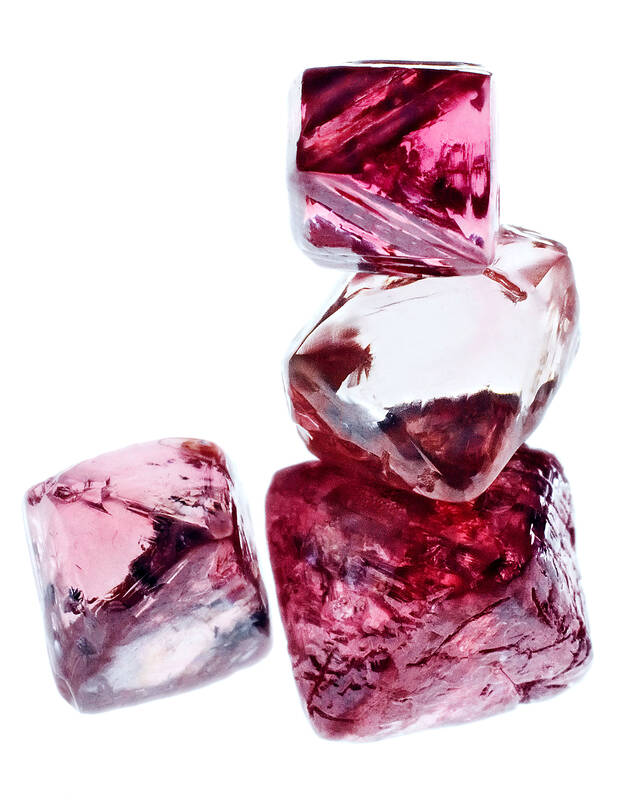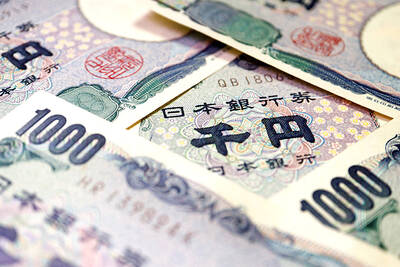Scientists said they have found the “missing ingredient” for pink diamonds, some of the world’s most expensive stones due their rarity and beauty, and the discovery could help find more.
More than 90 percent of all the pink diamonds ever found were discovered at the recently closed Argyle mine in the remote north of Western Australia.
Yet exactly why Argyle — which unlike most other diamond mines does not sit in the middle of a continent, but on the edge of one — produced so many pink gems has remained a mystery.

Photo: AFP / Nature Publishing Group / Traffic Studio #B
In a new study published in the journal Nature Communications, a team of Australia-based researchers said the pink diamonds were brought to the Earth’s surface by the break-up of the first supercontinent about 1.3 billion years ago.
Hugo Olierook, a research fellow at Curtin University in the state of Western Australia and the study’s lead author, on Tuesday said that two of the three ingredients for forming pink diamonds had already been known.
The first ingredient is carbon — and it must be in the bowels of Earth.
Anything shallower than 150km deep would be graphite — “that stuff in your pencils, not nearly as pretty on an engagement ring,” Olierook said.
The second ingredient is just the right amount of pressure, to damage the otherwise clear diamonds.
“Push just a little bit and it turns pink. Push a little too hard and they turn brown,” he said.
Most of the diamonds discovered at Argyle were of the less valuable brown hue, he added.
The missing ingredient was the volcanic event that sent the diamonds shooting up to the Earth’s surface, where humans could get their hands on them.
In the 1980s it was estimated that the Argyle diamonds emerged 1.2 billion years ago, but there was no “trigger” for the rare diamonds to rise at that time, Olierook said, so the researchers sought to establish a more accurate time line.
They used a laser thinner than a human hair to probe tiny crystals in an Argyle rock sample supplied by the mine’s owner, Anglo-Australian mining giant Rio Tinto Group.
By measuring the age of elements in the crystals, the researchers determined that Argyle was 1.3 billion years old — meaning the diamonds came up 100 million years later than previously thought.
That lines up with the breakup of the world’s first supercontinent, known as Nuna or Columbia.
In Nuna, “just about every single landmass on Earth was squashed together,” Olierook said.
The immense pressure that twisted color into the diamonds — the second ingredient — occurred during collisions between western Australia and northern Australia 1.8 billion years ago.
When Nuna started to break up 500 million years later, it reaggravated the “scar” from that event, Olierook said.
Magma shot up through this old scar “like a champagne cork going off,” taking the diamonds along for the ride, he said.
Study coauthor Luc Doucet said that such a “massive explosion” — which sent the diamonds traveling at near the speed of sound — has not taken place in recorded human history.
Over the past 200 years, people have mostly looked for diamonds in the center of massive continents.
However, knowing the “missing ingredient” for pink diamonds could assist future efforts to find the rare stones, Olierook said, adding that discovering more was unlikely to be easy or quick.
Old mountain belts marking Nuna’s breakup near the edges of continents have the potential to be home to a new “pink diamond paradise,” he said, naming Canada, Russia, southern Africa and Australia as possible locations.
John Foden, a professor and expert on diamonds at the University of Adelaide not involved in the study, said that the researchers had “convincingly shown” the age of the Argyle diamonds.
However, he said that other diamond-rich provinces had also been linked to Nuna’s breakup — and they had not produced pink diamonds.
This suggests that “pinkness seems to be a local Argyle attribute,” he said.
The Argyle mine closed in 2020 due to “various financial reasons,” Olierook said, meaning the value of pink diamonds could continue to rise as supply stalls.

AI TALENT: No financial details were released about the deal, in which top Groq executives, including its CEO, would join Nvidia to help advance the technology Nvidia Corp has agreed to a licensing deal with artificial intelligence (AI) start-up Groq, furthering its investments in companies connected to the AI boom and gaining the right to add a new type of technology to its products. The world’s largest publicly traded company has paid for the right to use Groq’s technology and is to integrate its chip design into future products. Some of the start-up’s executives are leaving to join Nvidia to help with that effort, the companies said. Groq would continue as an independent company with a new chief executive, it said on Wednesday in a post on its Web

RESPONSE: The Japanese Ministry of Finance might have to intervene in the currency markets should the yen keep weakening toward the 160 level against the US dollar Japan’s chief currency official yesterday sent a warning on recent foreign exchange moves, after the yen weakened against the US dollar following Friday last week’s Bank of Japan (BOJ) decision. “We’re seeing one-directional, sudden moves especially after last week’s monetary policy meeting, so I’m deeply concerned,” Japanese Vice Finance Minister for International Affairs Atsushi Mimura told reporters. “We’d like to take appropriate responses against excessive moves.” The central bank on Friday raised its benchmark interest rate to the highest in 30 years, but Bank of Japan Governor Kazuo Ueda chose to keep his options open rather than bolster the yen,

Even as the US is embarked on a bitter rivalry with China over the deployment of artificial intelligence (AI), Chinese technology is quietly making inroads into the US market. Despite considerable geopolitical tensions, Chinese open-source AI models are winning over a growing number of programmers and companies in the US. These are different from the closed generative AI models that have become household names — ChatGPT-maker OpenAI or Google’s Gemini — whose inner workings are fiercely protected. In contrast, “open” models offered by many Chinese rivals, from Alibaba (阿里巴巴) to DeepSeek (深度求索), allow programmers to customize parts of the software to suit their

Global server shipments are expected to surge to 15 million units next year, from 4 million units this year, with artificial intelligence (AI) servers accounting for about 30 percent, driven by massive capital spending by major cloud service providers, the Market Intelligence and Consulting Institute (MIC) said on Thursday last week. Major cloud service providers — including Google’s parent company Alphabet Inc, Microsoft Corp, Amazon.com Inc and Meta Platforms Inc — are projected to budget US$450 million for capital expenditure next year, up from US$400 million this year, MIC ICT [information and communications technology] Industry Research Center director Edward Lin